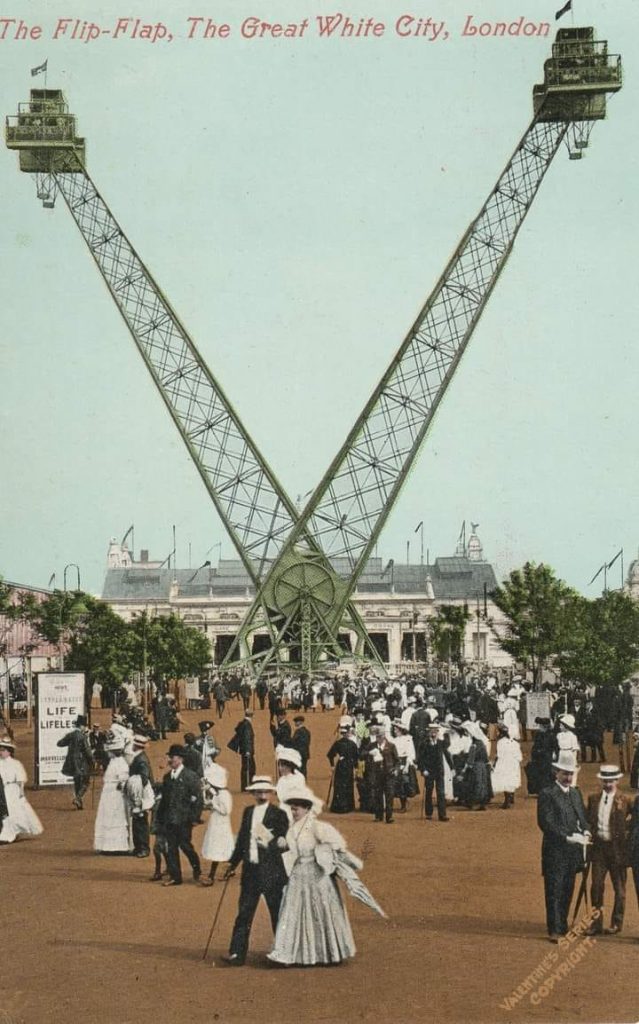
This postcard of the Flip Flap, in The White City, London is from a Valentine’s Series published during the Japan – British Exhibition of 1910. From the address side we learn that it is an “Official Post Card.”
Cards with this image and others with different assortments of people in the foreground are relatively common. Each card references the Great White City in London. White City is a district in the borough of Hammersmith, about 5.5 miles from Trafalgar Square, a trip between the two places could made via the Underground in about twenty-five minutes. The district was named for the white marble-like facades used on buildings designed to be exhibit halls during several exhibitions held when the area was redeveloped as public space between 1908 and 1914.
Before its development much of Hammersmith was farmland. In 1908, 104 acres were used as the site of the Franco-British Exhibition, then the 1908 Summer Olympics, and later the 1909 Imperial International Exhibition and the 1910 Japan-British Exhibition. There then followed the Latin-British Exhibition of 1912 and the 1914 Anglo-American Exhibition. The last in this series of events was brought to an early close due to the start of the First World War.
The 1908 Franco-British Exhibition was a celebration of the Entente Cordiale. [The Entente Cordiale was a series of agreements signed in April 1904 between the United Kingdom and the French Republic. It created substantial enhancements in the relationship between France and Great Britian. Ostensibly, the agreement dealt with minor issues related to open-ocean fishing and colonial boundaries of “protectorate” and “dominion” countries on six continents.]
The Flip Flap was a showpiece for the 1908 Franco-British Exhibition in much the same spirit that the Eiffel Tower was the center of the Paris World’s Fair in 1889. As the main attraction, the Flip Flap had two arms that were 150 feet long with a carriage appended to the ends, each with a capacity of 40 people. It took three minutes and 20 seconds for the journey from one side to the other and cost six pence.
There were other “ride-on attractions” such as a scenic mountain railway, Canadian toboggan run, and spiral ride, but none reached the popularity of the Flip Flap.
The Flip Flap was so successful in capturing the imagination of the public that at least three songs were composed about it. After all, receipts show that 1,110,800 people paid the sixpence for the privilege of a ride. The Flip Flap was sold for scrap metal in 1937.
“The Exhibition was open from 11 AM until 11 PM, Monday to Saturday from May 14th until the end of October 1908. In the bandstands around the exhibition regimental bands played throughout the day. Visitors paid one shilling (5p) to see the exhibition and when it closed more than 8.2 million people had paid the admission fee.
I have a few cards of the Flip Flap but not necessarily because it first appeared at the 1908 Exhibition. It was fabricated by the Cleveland Bridge and Engineering Company of Darlington, my home town. and I used to pass their works on my way to school in the 1950s. The company has gone now, but left behind a huge legacy of engineering achievements all over the world, many of which can be found on postcards.
It’s interesting that it cost a penny more just to ride the Flip-Flap than to be admitted to the fairgrounds.
No! One shilling entry in those days was 12 pence ie double the price of a ride on the Flip Flap!